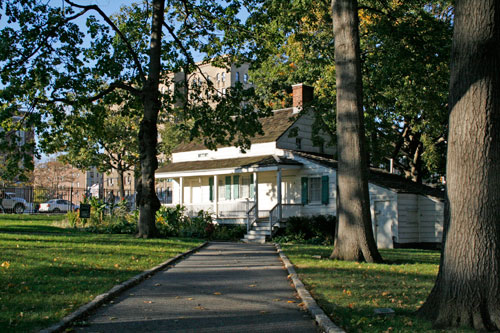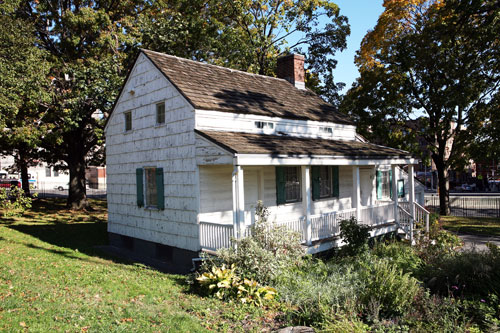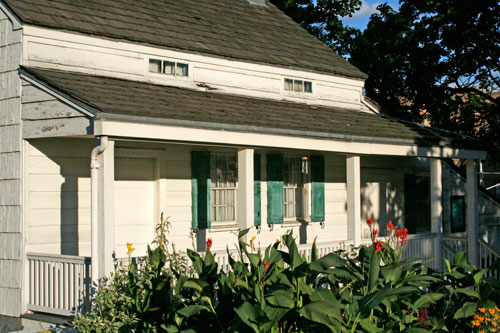Poe Cottage
Edgar Allan Poe Cottage
2640 Grand Concourse at s.e. corner of Kingsbridge Road
John Wheeler, builder
ca. 1812
The unpretentious 1-1/2 story white frame farmhouse, at the north end of Poe Park, was the last home of American writer Edgar Allan Poe (1809-1849) who resided here from 1846 to 1849. One of the most celebrated 19th century literary figures, Poe is perhaps best remembered for his gothic tales, detective stories and poetry. It was in this very house that Poe wrote Annabel Lee, The Bells, Ulalune, and Eureka. This simple frame structure is also thought to have inspired Poe’s short story Landor’s Cottage. Poe moved into this house, then in the village of Fordham, with his ailing wife Virginia and mother-in-law, Maria Clemm. He hoped that the benefit of country air would cure his wife’s tuberculosis, but sadly she died in the house.
The cottage was originally on Kingsbridge Road, southeast of the edge of Poe Park. When the road was widened in 1896, the cottage had to be moved back 25 feet and was jammed against its landlord’s adjacent house. The New York Shakespeare Society successfully lobbied the state legislature to create a park for the relocation of the cottage on what was then an apple orchard. $100,000 was allocated for the move and site renovation and Poe Park finally opened in 1902. The cottage, however, remained in private hands providing rental income for its owner. No money had been allocated by the legislature for the purchase of the house. When New York City finally acquired the cottage in 1913 it moved the house 450 feet north of its original location to the new park. In 1917, the Bronx Society of Arts and Sciences opened the cottage as a museum.

Now set on a brick foundation with a raised basement to accommodate a caretaker’s apartment, the cottage itself has an asymmetrical plan. A sitting room, bedroom and kitchen wing are on the first floor; and a staircase leads to the attic revealing two small rooms. The main structural supports, hand-hewn roof beams, plank floors, staircase and fireplaces are all original to the house. A door and windows damaged in the 1913 move of the house were replaced from old nearby homes. The shed was reconstructed and the porch, steps and balustrade were replaced. Interior restorations were made in 1921 by John Harden who replaced some woodwork and mantelpieces over the fireplaces in the original style. Bricks from the old Macomb home in the Bronx helped rebuild the kitchen flue and fireplace. The gabled roof now has fire resistant shingles in place of its original wood singles. The cottage is in a serene green space today surrounded by brick apartment buildings. It is a visual reminder of Poe’s life in a modest 19th century cottage in a more countrified part of what was to become the Bronx.
Poe Cottage was designated a New York City Landmark in 1966 and was listed on the National Register of Historic Places in 1980. The Bronx County Historical Society has been administering the cottage, since 1976, as a literary historic house museum open to the public.
Janet Butler Munch
Photographs:
Kareema Hussein



